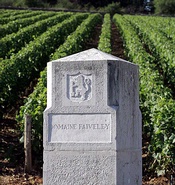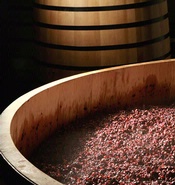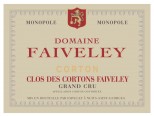|
|
 |

When I last paid a visit to the famous Burgundy house of Faiveley, the year was 2007 and things were in flux. I was told that the wines I was tasting weren’t indicative of the stylistic direction in which Faiveley was headed. The wines before me were notably hard and even rather austere,  and not just in my judgment: That same assessment was shared and even forwarded by my hosts. Nevertheless, I was told, a change was afoot that would yield more approachable and generous wines. and not just in my judgment: That same assessment was shared and even forwarded by my hosts. Nevertheless, I was told, a change was afoot that would yield more approachable and generous wines.
My reaction? “Time will tell” is about right as a characterization of what I thought at the time, though my natural skepticism probably salted this tentative reaction with an edge of, “talk is cheap” and “easier said than done.”
Well, with five years having passed since then, the time seems right for a re-assessment, and that’s what I’ve been doing for the past few months. I’ve focused on Faiveley wines from the 2010 vintage, which provides a near-perfect test case. The growing season in 2010 afforded vintners an opportunity to achieve full physiological ripeness in their grapes, but natural acidity levels were unusually high for Chardonnay and especially for Pinot Noir. Consequently, if the team at Faiveley had yet to complete the transformation forecasted in 2007, the 2010 vintage would have illuminated that fact in a very harsh light.
That isn’t the way things worked out. On the contrary, Faiveley’s 2010 wines are brilliant. They show the bright, fresh character of the vintage, but are beautifully balanced already, though both the whites and reds are capable of benefitting from relatively long ageing. Moreover, the wines are highly individuated, showing the classic profiles of the various communal terroirs that run down the Côte de Nuits and Côte de Beaune and into the Côte Chalonnaise. And, as if this wasn’t enough, it isn’t just  Faiveley’s domaine wines that are so impressive, but also the negociant wines made from vineyards owned by others. Even the 2010 Bourgogne Blanc is strikingly excellent, priced in the teens but tasting like a $35 wine from Puligny or Chassagne. Faiveley’s domaine wines that are so impressive, but also the negociant wines made from vineyards owned by others. Even the 2010 Bourgogne Blanc is strikingly excellent, priced in the teens but tasting like a $35 wine from Puligny or Chassagne.
Just for the record, I virtually never gush about a producer as I am here. And for good reason, because turnarounds like this are very rare, especially when the producer is already famous and flush, which was certainly true of Faiveley prior to the recent transformation. The house was roughly as well known as the comparable establishments of Jadot, Drouhin and Louis Latour, but was arguably even more flush in terms of vineyard holdings, turning out an extremely high percentage of domaine wines from highly desirable estate vineyards (including wholly owned monopole sites in Corton and Gevrey-Chambertin that could make any house in Burgundy turn green with envy).
Faiveley was akin to a famed aristocrat endowed with a lavish trust fund. Such people aren’t typically afflicted with self-doubt, nor do they often commit themselves resolutely to wholesale projects of self-improvement. Companies are not much different from individuals in this regard, so a little gushing about what has been accomplished at Faiveley seems entirely appropriate to me.
You can judge that for yourself, and thankfully most of the 2010s from Faiveley are still available in restaurants and retail stores. Here are abbreviated notes on some of my favorites from the vintage. Given how well these turned out, you can be damned sure that I’ll be stalking the 2011s, so stay tuned for an update.
WHITES:
Joseph Faiveley Bourgogne Blanc Chardonnay 2010 ($16 - $19): One  can tell that this is a negociant wine rather than an estate-grown domaine wine by the Joseph Faiveley designation, and the general categories of Bourgogne Blanc and Rouge are filled with mediocre wines, so you could be forgiven for underestimating this wine. Indeed, given how complex and compelling it turns out to be, I can’t imagine how anyone could manage not to underestimate it prior to tasting. It shows wonderful aromas of green apples, wet stones and light toast, following them up with flavors that are broad and substantial even though the wine has excellent linear drive and a sharply focused finish enlivened with fresh acidity and pronounced mineral notes. This may just be the most impressive of all the wines reviewed here, all things considered. 90 can tell that this is a negociant wine rather than an estate-grown domaine wine by the Joseph Faiveley designation, and the general categories of Bourgogne Blanc and Rouge are filled with mediocre wines, so you could be forgiven for underestimating this wine. Indeed, given how complex and compelling it turns out to be, I can’t imagine how anyone could manage not to underestimate it prior to tasting. It shows wonderful aromas of green apples, wet stones and light toast, following them up with flavors that are broad and substantial even though the wine has excellent linear drive and a sharply focused finish enlivened with fresh acidity and pronounced mineral notes. This may just be the most impressive of all the wines reviewed here, all things considered. 90
Domaine Faiveley Montagny 2010 ($20): Another remarkable bargain, this shows lovely fruit recalling green apples and slightly under-ripe tangerines. Fresh and energetic thanks to lots of bright acidity, this never turns tart, and the finish shows very nice minerality. 90
Domaine Faiveley Mercurey Monopole “Clos Rochette” 2010 ($30): The team at Faiveley speaks of the wine from this 4.4 hectare site as a “little Meursault,” and that seems entirely apt in this vintage. Notes of baked apples and fresh peaches are ripe but still quite bright, and subtly smoky, toasty wood accents are very nicely tuned to the weight and flavor impact of the fruit. 91
REDS:
Domaine Faiveley Mercurey 2010 ($25): This wine was very good in 2009, an indisputably great vintage for red wines in Burgundy, but when tasted side, the 2010 is still notably better. It shows excellent dimension and structure on a relatively lean frame, with lots of aroma and flavor but no extraneous weight. The tannins are notable but very well measured, and this will become even more complex over the next three or four years. 90
Domaine Faiveley Mercurey Monopole “La Framboisere” 2010 ($35): By comparison to the entry-level Mercurey bottling, this shows more weight, depth of flavor, and length, with more wood influence too, but there’s excellent overall balance, with the ample fruit easily holding its own with the toasty, spicy wood notes. I re-tasted this 24 hours after opening it initially, and it remained remarkably fresh and focused over that span. 91
Joseph Faiveley Nuits-Saint-Georges 2010 ($55): Although this wine is rather tight and unyielding at the moment (in keeping with the classic profile of young wines from Nuits-Saint-Georges), it shows very appealing dark-toned fruit beneath the acidity, tannin and relatively light oak. Very well proportioned, this just needs time. 89+
Joseph Faiveley Gevrey-Chambertin 2010 ($60): This is a very successful negociant wine in this vintage, showing the intensity and power of Gevrey, but also the characteristic freshness and lift of the 2010 growing season. The dark cherry fruit shows both sweet and savory  dimensions, with a firm spine from tannin and oak, yet the finish is already quite generously flavorful. Hold this for five years if you can. 90 dimensions, with a firm spine from tannin and oak, yet the finish is already quite generously flavorful. Hold this for five years if you can. 90
Domaine Faiveley Beaune 1er Cru Clos de l’Écu 2010 ($65): Very serious for a wine from Beaune, this is sourced from a monopole site owned by Faiveley. It shows as much black cherry as red cherry profile to the fruit, with very nice backnotes of fresh meat, wild mushrooms and woodsmoke. Still rather taut with acidity but already quite expressive in aroma and flavor, this is delicious now but sure to improve for a minimum of 5 years. 92
Joseph Faiveley Vosne-Romanée 2010 ($78): I rarely recommend village wines from Vosne- Romanée, because they are invariably expensive due to the cachet of the name but are usually made from mediocre fruit drawn from the lower flats of the appellation. Well, this wine offers little relief on the price issue, but it certainly exceeds expectations in terms of performance. Although it shows the potential to unwind for years to come, and is sure to remain fresh on account of abundant acidity, this already shows lots of open charm, with red and black fruit notes, subtle edging from oak, and interesting savory backnotes recalling mushrooms and truffles. 91
Domaine Pommard 1er Cru “Les Rugiens” 2010 ($90): A complete, compelling wine, this shows terrific intensity and depth of flavor, yet somehow seems as delicate as it is powerful. Dark cherry fruit is accented with hints of fresh meat, wild mushrooms, and woodsmoke, with wood and grape tannins that lend appropriate grip without any astringency. 93
Domaine Faiveley Grand Cru Corton “Clos des Cortons Faiveley” 2010 ($190): Of all the Grand Cru red wines of Burgundy, those from  Corton are almost always the most affordable, so a look at the price of this wine might make you raise an eyebrow. But this thing is, a taste of the wine will get you to raise the other eyebrow as well. It shows outstanding depth and concentration for a Corton, with excellent intensity and persistence of flavor, but manages to do this without seeming weighty or over-ripe. There’s notable oak on the nose and mid-palate, but certainly not so much as to obscure the fruit or the savory and mineral notes as the wine finishes. Best after 2017, and a good bet to drink well until 2030. 96 Corton are almost always the most affordable, so a look at the price of this wine might make you raise an eyebrow. But this thing is, a taste of the wine will get you to raise the other eyebrow as well. It shows outstanding depth and concentration for a Corton, with excellent intensity and persistence of flavor, but manages to do this without seeming weighty or over-ripe. There’s notable oak on the nose and mid-palate, but certainly not so much as to obscure the fruit or the savory and mineral notes as the wine finishes. Best after 2017, and a good bet to drink well until 2030. 96
|
 |
|